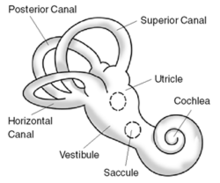
Back دوار الوضعة الانتيابي الحميد Arabic Vertigen posicional paroxístic benigne Catalan Øresten Danish Benigner paroxysmaler Lagerungsschwindel German Vértigo postural paroxístico benigno Spanish سرگیجه وضعیتی حملهای خوشخیم Persian Hyvänlaatuinen asentohuimaus Finnish Vertige paroxystique positionnel bénin French ורטיגו פרוקסיזמלי פריפרי HE Benigni paroksizmalni pozicijski vertigo Croatian
| Benign paroxysmal positional vertigo | |
|---|---|
 | |
| Exterior of labyrinth of the inner ear | |
| Specialty | Otorhinolaryngology |
| Symptoms | Repeated periods of a spinning sensation with movement[1] |
| Usual onset | Age from 50s to 70s[2] |
| Duration | Episodes less than a minute[3] |
| Risk factors | Older age, minor head injury[3] |
| Diagnostic method | Positive Dix–Hallpike test after other possible causes have been ruled out[1] |
| Differential diagnosis | Labyrinthitis, Ménière's disease, stroke, vestibular migraine[3][4] |
| Treatment | Epley maneuver or Brandt–Daroff exercises[3][5] |
| Prognosis | Resolves in days to months[6] |
| Frequency | 2.4% affected at some point[1] |
Benign paroxysmal positional vertigo (BPPV) is a disorder arising from a problem in the inner ear.[3] Symptoms are repeated, brief periods of vertigo with movement, characterized by a spinning sensation upon changes in the position of the head.[1] This can occur with turning in bed or changing position.[3] Each episode of vertigo typically lasts less than one minute.[3] Nausea is commonly associated.[7] BPPV is one of the most common causes of vertigo.[1][2][8]
BPPV is a type of balance disorder along with labyrinthitis and Ménière's disease.[3] It can result from a head injury or simply occur among those who are older.[3] Often, a specific cause is not identified.[3] When found, the underlying mechanism typically involves a small calcified otolith moving around loose in the inner ear.[3] Diagnosis is typically made when the Dix–Hallpike test results in nystagmus (a specific movement pattern of the eyes) and other possible causes have been ruled out.[1] In typical cases, medical imaging is not needed.[1]
BPPV is easily treated with a number of simple movements such as the Epley maneuver or Half Somersault Maneuver (in case of diagonal/rotational nystagmus), the Lempert maneuver (in case of horizontal nystagmus), the deep head hanging maneuver (in case of vertical nystagmus) or sometimes the less effective Brandt–Daroff exercises.[3][5] Medications, including antihistamines such as meclizine,[9] may be used to help with nausea.[7] There is tentative evidence that betahistine may help with vertigo, but its use is not generally needed.[1][10] BPPV is not a serious medical condition,[7] but may present serious risks of injury through falling or other spatial disorientation-induced accidents.
When untreated, it might resolve in days to months;[6] however, it may recur in some people.[7] One can needlessly suffer from BPPV for years despite there being a simple and very effective cure. Short-term self-resolution of BPPV is unlikely because the effective cure maneuvers induce strong vertigo which the patient will naturally resist and not accidentally perform.
The first medical description of the condition occurred in 1921 by Róbert Bárány.[11] Approximately 2.4% of people are affected at some point in time.[1] Among those who live until their 80s, 10% have been affected.[2] BPPV affects females twice as often as males.[7] Onset is typically in people between the ages of 50 and 70.[2]
- ^ a b c d e f g h i Bhattacharyya N, Baugh RF, Orvidas L, Barrs D, Bronston LJ, Cass S, et al. (November 2008). "Clinical practice guideline: benign paroxysmal positional vertigo". Otolaryngology–Head and Neck Surgery. 139 (5 Suppl 4): S47 – S81. doi:10.1016/j.otohns.2008.08.022. PMID 18973840. S2CID 16175316.
- Lay summary in: "ENT doctors release national guideline on treatment for common cause of dizziness". EurekAlert.org (Press release). 1 November 2008.
- ^ a b c d Dickson G (2014). Primary Care ENT, An Issue of Primary Care: Clinics in Office Practice, Volume 41, Issue 1 of The Clinics: Internal Medicine. Elsevier Health Sciences. p. 115. ISBN 978-0-323-28717-3. Archived from the original on 15 August 2016. Retrieved 25 July 2016.
- ^ a b c d e f g h i j k l "Balance Disorders". National Institute for Deafness and Other Communication Disorders (NIDCD). 10 August 2015. Archived from the original on 27 July 2016. Retrieved 25 July 2016.
- ^ Ferri FF (2016). Ferri's Clinical Advisor 2017 E-Book: 5 Books in 1. Elsevier Health Sciences. p. 170. ISBN 978-0-323-44838-3. Archived from the original on 8 September 2017.
- ^ a b Hilton MP, Pinder DK (December 2014). "The Epley (canalith repositioning) manoeuvre for benign paroxysmal positional vertigo". The Cochrane Database of Systematic Reviews (12): CD003162. doi:10.1002/14651858.CD003162.pub3. PMC 11214163. PMID 25485940.
- ^ a b "Benign Paroxysmal Positional Vertigo". NORD (National Organization for Rare Disorders). Retrieved 19 January 2020.
- ^ a b c d e "Positional vertigo: Overview". PubMed Health. 30 January 2014. Retrieved 25 July 2016.
- ^ Kim HJ, Park J, Kim JS (May 2021). "Update on benign paroxysmal positional vertigo". Journal of Neurology. 268 (5): 1995–2000. doi:10.1007/s00415-020-10314-7. PMC 7684151. PMID 33231724.
- ^ "Meclizine Hydrochloride Monograph for Professionals". Drugs.com. American Society of Health-System Pharmacists. Retrieved 22 March 2019.
- ^ Murdin L, Hussain K, Schilder AG (June 2016). "Betahistine for symptoms of vertigo". The Cochrane Database of Systematic Reviews. 2016 (6): CD010696. doi:10.1002/14651858.CD010696.pub2. PMC 7388750. PMID 27327415.
- ^ Daroff RB (2012). "Chapter 37". Bradley's neurology in clinical practice (6th ed.). Philadelphia, PA: Elsevier Saunders. ISBN 978-1-4557-2807-7. Archived from the original on 21 December 2016.